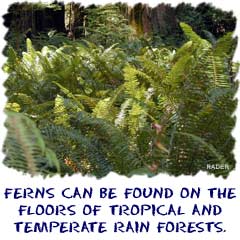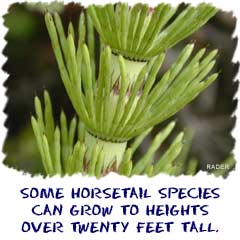
Ferns and Horsetails -
First Plants with Pipes
These are the first of the vascular plants you will study. Mosses and worts are non-vascular. The ferns were the first plant species to develop a circulatory system that lets them grow larger. They have roots, leaves, stems, and trunks. With their new vascular system, the sky was the limit for plants.
They Like Water
 Ferns are often used in landscaping. There's a good chance you've seen them. They are also able to live in a variety of climates as long as it is moist. You will find ferns in Canadian rain forests just as easily as you will find them near the equator. They are similar to mosses in that they need liquid to reproduce. When water is around, they are able to have baby ferns called zygotes. Ferns have some neat structural features. Some have large stems, several feet in length. Scientists call those bad boys the tree ferns. Ferns also have specialized leaves called fronds. They unroll as they mature and spread out in a fan shape.
Ferns are often used in landscaping. There's a good chance you've seen them. They are also able to live in a variety of climates as long as it is moist. You will find ferns in Canadian rain forests just as easily as you will find them near the equator. They are similar to mosses in that they need liquid to reproduce. When water is around, they are able to have baby ferns called zygotes. Ferns have some neat structural features. Some have large stems, several feet in length. Scientists call those bad boys the tree ferns. Ferns also have specialized leaves called fronds. They unroll as they mature and spread out in a fan shape.
Horsetails
 Horsetails are related to ferns in that they have a vascular system. They never developed the ability to reproduce with seeds. They might be a little hard for you to see because many of them are extinct. Because they are better able to survive in various environments, you can find them from very northern and southern latitudes to the equator. Unlike ferns, these are tough plants. While ferns are soft, horsetails are rough plants and even have silica (silicon-based compound) in their epidermal cells. Ouch!
Horsetails are related to ferns in that they have a vascular system. They never developed the ability to reproduce with seeds. They might be a little hard for you to see because many of them are extinct. Because they are better able to survive in various environments, you can find them from very northern and southern latitudes to the equator. Unlike ferns, these are tough plants. While ferns are soft, horsetails are rough plants and even have silica (silicon-based compound) in their epidermal cells. Ouch!
Related Video...
Hardy Evergreen Ferns (Clemson University Video)
Encyclopedia.com (Fern):
http://www.encyclopedia.com/topic/fern.aspx
Wikipedia (Fern):
http://en.wikipedia.org/wiki/Fern
Wikipedia (Horsetail):
http://en.wikipedia.org/wiki/Equisetum
Encyclopædia Britannica (Fern):
http://www.britannica.com/EBchecked/topic/204819/fern
Encyclopædia Britannica (Horsetail):
http://www.britannica.com/EBchecked/topic/272428/horsetail



